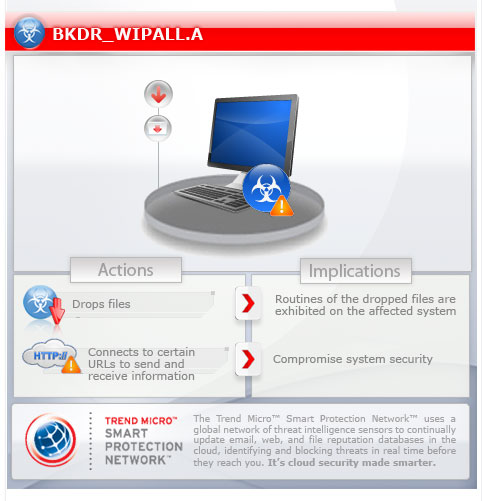BKDR_WIPALL.A
Windows


Threat Type: Backdoor
Destructiveness: No
Encrypted: No
In the wild: Yes
OVERVIEW
This backdoor contains a list of user names and passwords which it uses in its attempt to grant access to the System Root folder of an infected machine. It also installs another backdoor on the system. It is implicated in the Sony Pictures December 2014 attack.
To get a one-glance comprehensive view of the behavior of this Backdoor, refer to the Threat Diagram shown below.

This backdoor arrives on a system as a file dropped by other malware or as a file downloaded unknowingly by users when visiting malicious sites.
It executes the dropped file(s). As a result, malicious routines of the dropped files are exhibited on the affected system.
It connects to certain websites to send and receive information.
TECHNICAL DETAILS
Arrival Details
This backdoor arrives on a system as a file dropped by other malware or as a file downloaded unknowingly by users when visiting malicious sites.
Autostart Technique
This backdoor registers itself as a system service to ensure its automatic execution at every system startup by adding the following registry entries:
HKEY_LOCAL_MACHINE\SYSTEM\CurrentControlSet\
Services\WinsSchMgmt
ImagePath = "{malware path and filename} -k"
HKEY_LOCAL_MACHINE\SYSTEM\CurrentControlSet\
Services\WinsSchMgmt
Start = "2"
HKEY_LOCAL_MACHINE\SYSTEM\CurrentControlSet\
Services\WinsSchMgmt
DisplayName = "Windows Schedule Management Service"
HKEY_LOCAL_MACHINE\SYSTEM\CurrentControlSet\
Services\WinsSchMgmt
ObjectName = "LocalSystem"
It registers as a system service to ensure its automatic execution at every system startup by adding the following registry keys:
HKEY_LOCAL_MACHINE\SYSTEM\CurrentControlSet\
Services\WinsSchMgmt
ImagePath = "{malware path and filename} -k"
HKEY_LOCAL_MACHINE\SYSTEM\CurrentControlSet\
Services\WinsSchMgmt
Start = "2"
HKEY_LOCAL_MACHINE\SYSTEM\CurrentControlSet\
Services\WinsSchMgmt
DisplayName = "Windows Schedule Management Service"
HKEY_LOCAL_MACHINE\SYSTEM\CurrentControlSet\
Services\WinsSchMgmt
ObjectName = "LocalSystem"
HKEY_LOCAL_MACHINE\SYSTEM\CurrentControlSet\
Services\WinsSchMgmt
Description = "Windows Schedule Management Service"
Dropping Routine
This backdoor drops the following files:
- {malware path}\igfxtrayex.exe - detected as BKDR_WIPALL.B
- %System%\net_ver.dat - contains the following information:
hostname | IP Address | 2
(Note: %System% is the Windows system folder, where it usually is C:\Windows\System32 on all Windows operating system versions.)
It executes the dropped file(s). As a result, malicious routines of the dropped files are exhibited on the affected system.
Other Details
This backdoor connects to the following website to send and receive information:
- {BLOCKED}.{BLOCKED}.215.64
- {BLOCKED}.{BLOCKED}.33.164
- {BLOCKED}.{BLOCKED}.222.102
NOTES:
This backdoor accepts any of the following arguments:
- -i
- -k
- -s
It attempts to log into shared network using a list of user names and passwords. Once logged in, it grants full access to the machine's System Root folder to everyone on the network.
SOLUTION
Step 1
Before doing any scans, Windows XP, Windows Vista, and Windows 7 users must disable System Restore to allow full scanning of their computers.
Step 2
Note that not all files, folders, and registry keys and entries are installed on your computer during this malware's/spyware's/grayware's execution. This may be due to incomplete installation or other operating system conditions. If you do not find the same files/folders/registry information, please proceed to the next step.
Step 3
Remove the malware/grayware file dropped/downloaded by BKDR_WIPALL.A. (Note: Please skip this step if the threat(s) listed below have already been removed.)
- BKDR_WIPALL.B
Step 4
Restart in Safe Mode
Step 5
Delete this registry key
Important: Editing the Windows Registry incorrectly can lead to irreversible system malfunction. Please do this step only if you know how or you can ask assistance from your system administrator. Else, check this Microsoft article first before modifying your computer's registry. Before you could do this, you must restart in Safe Mode. For instructions on how to do this, you may refer to this page If the preceding step requires you to restart in safe mode, you may proceed to edit the system registry.
- In HKEY_LOCAL_MACHINE\SYSTEM\CurrentControlSet\Services
- WinsSchMgmt
- WinsSchMgmt
Step 6
Restart in normal mode and scan your computer with your Trend Micro product for files detected as BKDR_WIPALL.A. If the detected files have already been cleaned, deleted, or quarantined by your Trend Micro product, no further step is required. You may opt to simply delete the quarantined files. Please check this Knowledge Base page for more information.
Did this description help? Tell us how we did.

